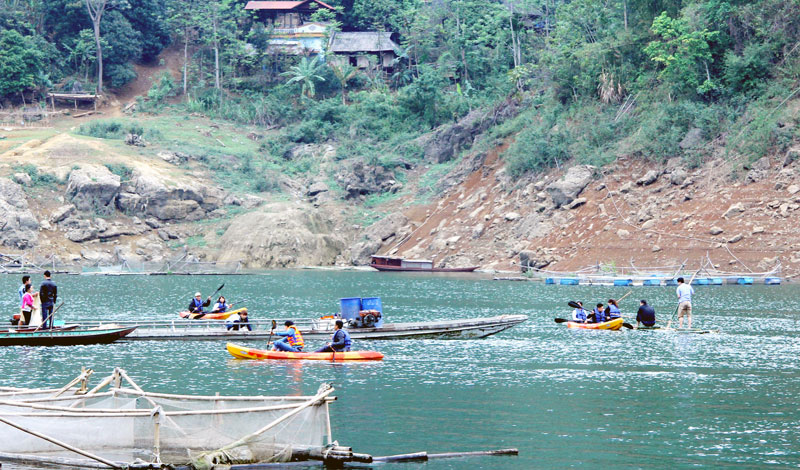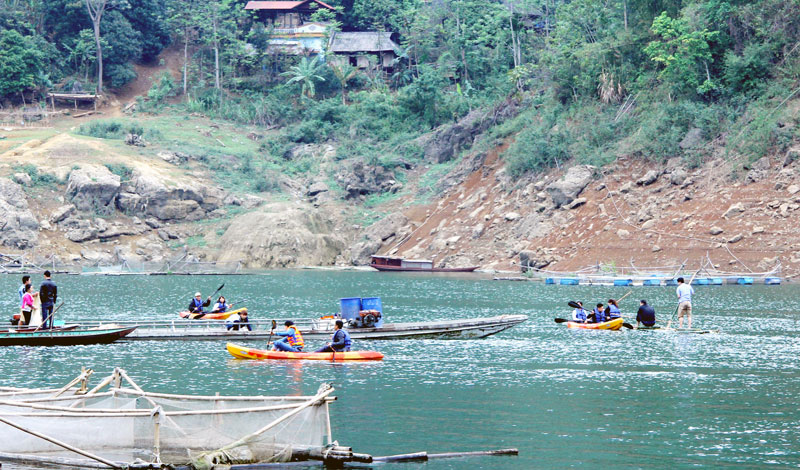
(HBO) - – Dua (Coconut) Island is a must-see destination to visitors who want to explore the Hoa Binh Lake area in the northern mountainous province of Hoa Binh.

Exploring
Hoa
Binh
Lake in
Dua
Island by raft .
Departing
from Thung Nai wharf, it takes about 30 minutes by boat to get
Dua
Island,
which is one of the most beautiful islands in the
Hoa
Binh
Lake in Vay Nua commune, Da Bac
district. Adjacent to the Chua Thac Bo temple, the 10-ha island is the meeting
venue of cloud and mountain.
Unlike other islands in the lake,
Dua
Island is covered with
the green of hundreds of coconut trees. Nguyen Dinh Tuy, owner of the island,
has spent time in planning, upgrading and seeking new varieties of coconut and
many other fruit trees to plant on the island.
Dua
Islandhas been developed into a tourist destination for many years with improved
service quality, meeting demands of visitors to explore the nature and culture
in the
Hoa
Binh
Lakearea.
Tuy
built big stilt houses of Muong and Thai ethnic groups on the island, with each
of them accommodating from 30-50 people, and eight small stilt houses equipped
with conveniences. There is a kitchen that can serve hundreds of people at the
same time, along with entertainment areas, allowing tourists to contemplate the
landscape, set up a campfire, fish and paddle boats. There are also houses for
small families on the island.
Vacationers can stroll around the island, freely pick fruits in orchards of
mango, sapodilla, longan and lychee, or paddle boats to visit surrounding
islands. They can also ride drug-out canoes at moonlight night and taste local
dishes hosted by the island owner like smoked fish, forest vegetables and roast
pork.
Tuy has also invested in passenger and motor boats to bring visitors to
surrounding tourist destinations like Thac Bo temple, Thac Bo cave, Tinh Yeu
(Love) waterfall, Ngoi Hoa bay, Hoa Tien cave, Coi Xay Gio (Windmill) island,
Xanh island and Ngoc island.
Thanks
to the power system and mobile service cover, holiday-makers can still access
information and handle their work while staying on the island.
Dua
Island has become an attractive
destination, luring a lot of visitors because of its primitive beauty.
Located just a 20-minute drive from Hoa Binh City, Ora Hill Farmstay & Glamping Hoa Binh is a captivating new destination nestled in Mo hamlet, Bình Thanh commune, Cao Phong district. Combining farming with leisure, this tranquil retreat is perfect for those seeking balance, joy, and an immersive experience in the expansive beauty of nature.
Muong Bi - Tan Lac is renowned as one of the four famous Muong regions in Hoa Binh province. Blessed by nature with a favourable climate and stunning landscapes, Tan Lac holds great advantages for tourism development. The local tourism industry has made remarkable strides in recent times thanks to the attention and support from the local authorities and sectors.
With its strategic location, well-developed transport network, and diverse soil and climatic conditions, Hoa Binh is emerging as a must-visit destination in Vietnam's northwestern tourism corridor. The province boasts numerous attractions, including the Kim Boi hot springs (Kim Boi district), the Dau Rong cave complex (Cao Phong), the Mai Chau valley (Mai Chau), and the iconic Hoa Binh hydropower plant.
The northern mountainous province of Hoa Binh has been listed among the 71 most beautiful places to visit worldwide by the prestigious US travel magazine Condé Nast Traveller.
Hoa Binh province’s rich natural and cultural resources position it as a prime location for developing community-based tourism (CBT). In recent years, support from central and provincial policies, as well as assistance from non-governmental organisations, have encouraged local ethnic minority and mountainous communities to actively engage in the sector.



